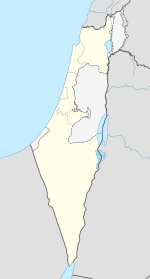- Nahariya
-
Nahariya Hebrew transcription(s) - Hebrew נַהֲרִיָּה - ISO 259 Nahriya Arabic transcription(s) - Arabic نهاريّا 
LogoCoordinates: 33°00′21″N 35°05′56″E / 33.00583°N 35.09889°ECoordinates: 33°00′21″N 35°05′56″E / 33.00583°N 35.09889°E District North Sub-district Acre Founded 1935 Government - Type City (from 1961) - Mayor Jacky Sabag Area - Total 10,233 dunams (10.2 km2 / 4 sq mi) Population (2009)[1] - Total 51,200 Nahariya (Hebrew: נַהֲרִיָּה) is the northernmost coastal city in Israel, with an estimated population of 51,200.[1]
Contents
Etymology
Nahariya, takes its name from the river - nahar in Hebrew - that bisects it.
History
Nahariya was founded by German Jewish immigrants from the Fifth Aliyah in the 1930s. Construction of homes started in 1933, and the first two families permanently settled in Nahariya on February 10, 1935, which is now considered the official founding date of Nahariya.
Nahariya was intended to be an agricultural village, but the residents soon realized that agriculture was impractical and chose to focus on tourism, taking advantage of the natural surroundings and beaches. During the British Mandate of Palestine, many British officers coming from Khartoum stopped in Nahariya.
Due to its geographic location 9.6 kilometers down the coast from Israel's border with Lebanon, Nahariya has been a frequent target of cross-border terrorist attacks, mortar attacks and Katyusha rocket fire. During the 2006 Lebanon War in July–August 2006, Nahariya sustained a barrage of several hundreds of Katyusha rockets launched by Hezbollah from southern Lebanon. As a result, the city suffered multiple civilian casualties and 5 fatalities. Significant damage was also inflicted on property and physical infrastructure. Nahariya's economy suffered a major blow, as two-thirds of the city's population had to evacuate, with the rest spending weeks in bomb shelters.
Economy
Nahariya is home to some of Israel's leading entrepreneurs: the Strauss, Soglowek and Wertheimer families. Successful private sector industrial enterprises founded in Nahariya are the Strauss dairy company, Soglowek meat processing company, and Iscar—the high-precision metalworks and tool-making giant, which was recently purchased by Berkshire Hathaway for US $5 billion.[2]
According to the CBS, as of 2000 there were 17,916 salaried workers in the city and 1,283 were self-employed. The mean monthly wage in 2000 for a salaried worker in the city was ILS 5,736, a real growth of 7.0% over the previous year. Salaried men have a mean monthly wage of ILS 7,353 (an increase of 7.6%) versus ILS 3,950 for women (increase of 2.5%). The mean income for the self-employed was 9,078. In the same year, there were 886 people who received unemployment benefits and 3,611 people living on fixed income (Social Security.)
Tourism
Sderot Ga'aton, the city's main boulevard, runs east-west from the Coastal Highway junction to the sea, and is divided down the middle by the Ga'aton River. Shaded by the thick greenery of towering eucalyptus trees and lined with numerous shops, boutiques, open-air cafes, restaurants and ice cream parlors, Sderot Ga'aton is Nahariya's main tourist attraction and its central business and entertainment district.[3]The beach area is an attraction in its own right, with a public park, a waterfront promenade, two public beaches, several hotels, a small marina and a lively nightlife in the multitude of beachfront cafes, bars, restaurants and nightclubs.
Transportation
Highway 4, the coastal highway, is the main north–south road in the city. Highway 89 starts at the Nahariya Junction in the city, and connects it with the rest of the Upper Galilee and Safed. Nahariya's public transportation hub is located at the eastern end of Sderot Ga'aton, near the intersection with Highway 4, and contains the city's train station and central bus station. Nahariya's train station is the northernmost station of the Israel Railways network. Sderot Ga'aton runs westward where the mouth of the Ga'aton River spills into the Mediterranean Sea.
Demographics
According to Israel Central Bureau of Statistics (CBS), in 2001 the ethnic makeup of the city was 97.3% Jewish and other non-Arabs, without significant Arab population. In 2001 there were 355 immigrants. See population groups in Israel. According to the CBS, in 2001 there were 22,200 males and 23,700 females. The population of the city was spread out with 29.5% 19 years of age or younger, 16.3% between 20 and 29, 18.8% between 30 and 44, 17.3% from 45 to 59, 4.1% from 60 to 64, and 13.9% 65 years of age or older. The population growth rate in 2001 was 4.2%.
Following Israel's withdrawal from Lebanon in 2000 many ex South Lebanon Army soldiers and officers who fled from Lebanon settled in Nahariya.
Education
According to the CBS, Nahariya has 22 schools with 7,541 students, which are divided into 15 elementary schools with 4,074 students, and 7 middle and high schools with 3,467 students. In 2001, high school (12th grade) matriculation rate in the city was 56.5%.
Notable residents
- Stef Wertheimer (born 1926), German-born Israeli entrepreneur, industrialist, and politician
Twin towns — Sister cities
Nahariya is twinned with:
 Alzey, Germany
Alzey, Germany Offenbach, Germany
Offenbach, Germany Darmstadt, Germany
Darmstadt, Germany Paderborn, Germany
Paderborn, Germany Issy-Les-Moulineaux, France
Issy-Les-Moulineaux, France Tempelhof-Berlin, Germany
Tempelhof-Berlin, Germany Bielefeld-NRW, Germany
Bielefeld-NRW, Germany Miami Beach-Florida, USA
Miami Beach-Florida, USA Delray Beach-Florida, USA
Delray Beach-Florida, USA Kecskemét-Bács-Kiskun, Hungary
Kecskemét-Bács-Kiskun, Hungary
References
- ^ a b "Table 3 - Population of Localities Numbering Above 2,000 Residents and Other Rural Population". Israel Central Bureau of Statistics. 2010-06-30. http://www.cbs.gov.il/population/new_2010/table3.pdf. Retrieved 2010-10-31.
- ^ Nahariya
- ^ "Nahariya". http://www.travelnet.co.il/israel/Haifa/haifa14-NAHARIYYA.htm. Retrieved 2007-12-17.
External links
- (Hebrew) Official website
Israeli cities with a 50,000+ population 500,000+ 200,000 – 499,999 100,000 – 199,999 50,000 – 99,999 Herzliya • Kfar Saba • Ra'anana • Hadera • Beit Shemesh • Modi'in-Maccabim-Re'ut • Lod • Nazareth • Ramla • Giv'atayim • Rahat • Nahariya • Kiryat AtaCategories:
Wikimedia Foundation. 2010.





